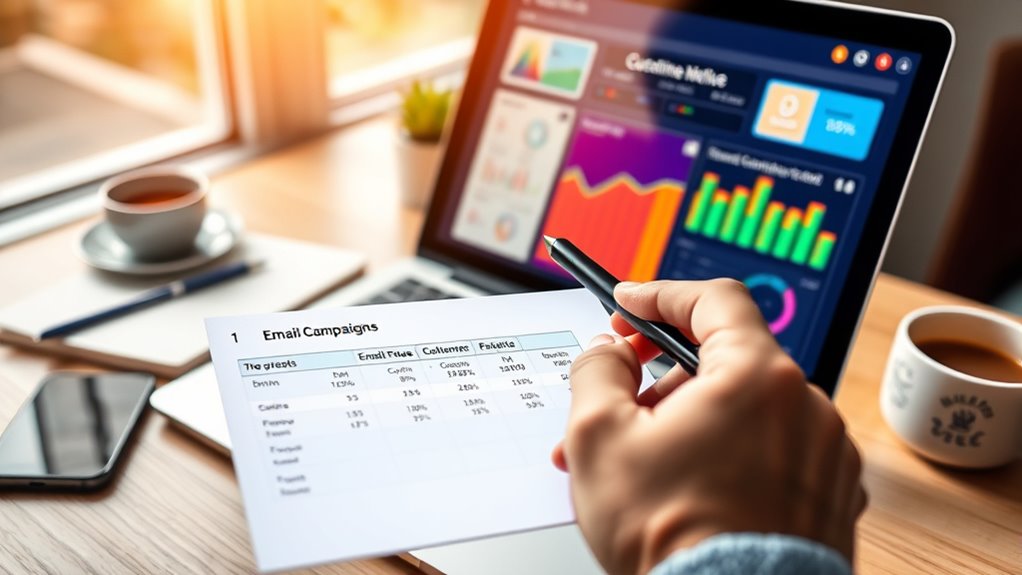To calculate your customer lifetime value from email alone, start by analyzing your email metrics like open rates, click-through rates, and revenue generated from email campaigns. Segment your audience based on engagement and purchase behavior to improve accuracy. Estimate how long a typical customer stays active and continues buying via email. Combining these insights will help you determine your LTV, and exploring further can reveal even more strategies to maximize your email marketing success.
Key Takeaways
- Calculate total revenue generated from email campaigns divided by total email subscribers to find average revenue per email subscriber.
- Segment customers based on engagement, purchase history, and preferences to identify high-value groups.
- Track key engagement metrics like open rates, click-through rates, and purchase frequency over time.
- Estimate customer lifespan by analyzing engagement patterns and retention rates within segments.
- Combine average revenue per subscriber with estimated customer lifespan to determine lifetime value for email-driven customers.
Gathering Your Email Data

Have you collected enough email data to accurately analyze your customer base? Gathering thorough data is essential for effective segmentation strategies and personalization tactics. You need to track key metrics like open rates, click-through rates, purchase history, and engagement patterns. This data helps you identify different customer segments, allowing you to tailor your email campaigns more precisely. This process often uncovers forgotten treasures and memories that can inform your marketing approach. Focus on collecting data consistently across your audience to guarantee accuracy. Use automation tools to segment your list based on behaviors and preferences, enabling targeted messaging. Personalization tactics become more effective when you understand your subscribers’ habits and needs. The more detailed your data collection, the better you can craft personalized content that drives engagement and boosts lifetime value.
Calculating Average Revenue Per Email Subscriber

To find your average revenue per email subscriber, you first need to determine your total revenue from email campaigns. Then, count your total number of subscribers to get a clear picture. Finally, divide the total revenue by the number of subscribers to see how much each one contributes on average. Understanding your subscriber base can also help you identify valuable segments for targeted marketing efforts.
Determine Total Revenue
Understanding your total revenue from email marketing is essential for accurately calculating the lifetime value of each subscriber. To do this, focus on tracking all sales generated through your email campaigns. Use segmentation strategies to target specific groups, ensuring your messaging resonates and boosts conversions. Personalization tactics, like tailored offers and relevant content, also enhance engagement and increase revenue per email. Combine these insights to total the income from your email efforts over a given period. Keep detailed records of campaign performance, including revenue attributed to each segment or personalized message. This all-encompassing view helps you see the true contribution of your email list, providing a solid foundation for calculating the overall lifetime value of your subscribers. Regular analysis of campaign metrics allows for continuous optimization and improved profitability.
Count Total Subscribers
How do you accurately determine the total number of email subscribers in your list? First, confirm you’re capturing clean data through segmentation strategies that exclude inactive or bounced emails. Next, regularly audit your list to remove duplicates and outdated contacts. Finally, apply personalization tactics to categorize subscribers based on behavior, which helps refine your count. This process improves the quality of your total subscriber number, guaranteeing you’re not overestimating your reach. Keep in mind that a precise count is essential for calculating average revenue per email subscriber. By segmenting your audience effectively and using targeted personalization, you gain a clearer picture of your active, engaged subscribers—setting a solid foundation for accurate lifetime value calculations. Additionally, understanding your anime movie preferences can help tailor your email content to better resonate with your audience.
Calculate Average Revenue
Ever wonder how much revenue each email subscriber generates on average? To find out, divide your total revenue by your total number of subscribers. But to get a more accurate picture, consider how email segmentation and personalization tactics can boost these numbers. Segmenting your list allows you to tailor content to specific groups, increasing engagement and purchase likelihood. Personalization makes your emails more relevant, encouraging recipients to buy more frequently or spend more per transaction. Track your revenue from each segment to identify high-value groups and optimize your campaigns accordingly. Implementing targeted strategies, like content personalization, can significantly improve your results. This approach helps you understand which subscribers are most profitable, so you can focus your efforts on nurturing those relationships and maximizing your average revenue per email subscriber.
Determining Customer Retention Rate

To determine your customer retention rate, you need to track how often customers repeat their engagement with your emails. Measuring how frequently customers churn helps you understand their loyalty over time. Focusing on these points gives you clear insights into how well you’re keeping your audience engaged. Monitoring the effectiveness of your Pimple Patch campaigns can also provide valuable data on customer preferences and repeat purchasing behavior.
Tracking Repeat Engagements
Tracking repeat engagements is essential for understanding your customer retention rate. By analyzing how often customers open, click, or interact with your emails, you gain valuable insights into their loyalty. To improve accuracy, focus on three key areas:
- Use segmentation strategies to categorize customers based on engagement frequency.
- Monitor engagement metrics such as open rates and click-through rates over time.
- Identify patterns indicating high or declining engagement to refine your retention efforts.
- Incorporate expert voice actors to craft compelling messaging that resonates and encourages ongoing interactions.
This approach helps you pinpoint which segments stay active and which need targeted re-engagement campaigns. Consistently tracking these interactions allows you to measure true customer retention levels, ultimately informing your lifetime value calculations and shaping smarter email marketing strategies.
Measuring Churn Frequency
Understanding how often customers stop engaging with your emails is essential for evaluating your retention rate. Measuring churn frequency helps you identify when customers become inactive, informing your customer segmentation efforts. To do this effectively, track the number of disengaged contacts over time, considering factors like email deliverability issues that may falsely suggest churn. Here’s a simple way to visualize this:
| Metric | Description |
|---|---|
| Churn Rate | Percentage of customers who stop engaging |
| Engagement Gap | Time between last interaction and inactivity |
| Retention Rate | Proportion of customers who remain active |
Additionally, monitoring security vulnerabilities in your email campaigns can help prevent potential data breaches affecting your customer information.
Estimating Customer Lifespan

Estimating customer lifespan is essential for accurately calculating lifetime value from email marketing efforts. To do this effectively, you need to analyze patterns like:
- How email segmentation impacts engagement over time
- The role of subject line testing in boosting open rates and prolonging interactions
- Customer response trends that indicate loyalty or churn risk
Computing Customer Lifetime Value (LTV) From Email

Once you’ve analyzed customer engagement patterns and identified factors that influence loyalty, the next step is to calculate their lifetime value from email marketing efforts. Start by applying segmentation strategies to group customers based on behaviors, preferences, and purchase history. This helps you tailor your messaging and offers, making your emails more relevant. Incorporate personalization tactics by customizing content, subject lines, and recommendations for each segment, which boosts engagement and increases the likelihood of repeat purchases. Track metrics like average purchase value, purchase frequency, and retention rate within each segment. Use this data to estimate individual customer LTVs, then aggregate these figures to determine your overall email-driven customer lifetime value. Additionally, understanding the benefits of yoga can inspire your messaging to foster emotional and mental well-being, further enhancing customer loyalty. This approach maximizes revenue potential and optimizes your email marketing ROI.
Analyzing and Interpreting Your Results

After collecting your email marketing data, the next essential step is to analyze and interpret the results to uncover meaningful insights. Focus on understanding patterns and trends that can inform your strategies. Consider these key steps:
- Use segmentation strategies to group customers based on behavior, purchase history, or engagement levels.
- Apply personalization tactics to tailor content and offers, increasing relevance and response rates.
- Monitor how different segments respond over time to refine your approach and improve lifetime value.
- Evaluate metrics such as contrast ratio and color accuracy to understand how visual elements influence customer engagement and perception.
Applying Your LTV to Optimize Email Marketing Strategies

Applying your customer lifetime value (LTV) to your email marketing strategies enables you to make smarter, data-driven decisions that maximize ROI. Use personalization tactics to tailor content based on individual customer behaviors and preferences, increasing engagement and conversions. Segmentation strategies help you divide your audience into meaningful groups, allowing for targeted messaging that resonates with specific segments. By understanding the LTV of different customer groups, you can allocate your email resources more effectively, focusing on high-value segments with tailored offers and content. This approach boosts retention and lifetime revenue, ensuring your email campaigns are both efficient and impactful. Ultimately, integrating your LTV insights into your email marketing enables you to nurture relationships and grow your customer value over time.
Frequently Asked Questions
How Often Should I Update My Email LTV Calculations?
You should update your email LTV calculations regularly to maintain accurate customer segmentation and data accuracy. How often depends on your business pace—monthly or quarterly updates work well for most. Frequent updates help you spot trends and adjust strategies promptly. Keep an eye on changing customer behaviors and guarantee your data stays current, so your LTV calculations reflect true value and guide effective marketing decisions.
Can Email LTV Predict Future Customer Spending Accurately?
Your question about email LTV predicting future customer spending accurately isn’t just important — it’s critical for your business’s survival. While email LTV provides valuable insights, it’s not a crystal ball. It can help with customer segmentation and churn prediction, but external factors influence spending. Use it as a guide, not a guarantee, and combine it with other data to improve accuracy and make smarter decisions.
How Do Seasonal Trends Affect Email LTV Estimates?
Seasonal fluctuations can markedly impact your email LTV estimates, as customer spending varies throughout the year. By incorporating trend analysis, you can identify patterns and adjust your LTV calculations accordingly. Recognizing these seasonal trends helps you refine your marketing strategies, ensuring you account for periods of higher or lower customer value. This approach allows you to make more accurate predictions and optimize your campaigns based on expected seasonal shifts.
What Tools Are Best for Tracking Email-Based Revenue?
When tracking email-based revenue, you want tools that excel in email analytics and revenue attribution. Platforms like Google Analytics, HubSpot, and Mailchimp offer robust features to monitor open rates, click-throughs, and conversions, helping you understand how your campaigns drive sales. These tools allow you to connect email activity directly to revenue, giving you clear insights into your email marketing effectiveness and enabling data-driven decisions.
How Does Email Personalization Impact LTV Calculation?
Email personalization profoundly impacts LTV calculations by enabling better customer segmentation and targeted personalization strategies. When you personalize emails based on customer behavior and preferences, you increase engagement and purchase frequency. This, in turn, raises your estimated lifetime value, as more personalized campaigns foster loyalty and repeat business. By accurately tracking these personalized interactions, you can refine your LTV models, making them more precise and reflective of individual customer contributions over time.
Conclusion
Now that you’ve cracked the code of email LTV, you might think it’s a magic trick. But really, it’s just math with a touch of patience. Imagine your emails as tiny cash cows, grazing patiently in your inbox field, waiting to be milked over time. So, while it may seem simple, don’t forget: behind every number is a story of your subscribers’ loyalty — or lack thereof. Happy calculating!
Natali – Editor in Chief (Strategy and Mastery, AI Expert) Natali, our Editor in Chief, is the driving force behind our content’s strategic direction. With a keen eye for detail and a deep understanding of market trends, Natali ensures that our content is top-notch and strategically aligned with our client’s goals. Her expertise in AI helps to seamlessly integrate advanced technology into our marketing strategies, pushing the boundaries of conventional marketing.









![Personalization Basics: Beyond "Hello [Name]" in Your Emails 25 advanced email personalization techniques](https://leftbrainmarketing.net/wp-content/uploads/2025/11/advanced_email_personalization_techniques_7bop8-260x140.jpg)
